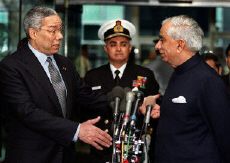Shifting of Alliances in Asia Furthers Islamophobic Agenda
Nothing more opportune could have come up for India than the introductory meeting its foreign minister, Jaswant Singh held with the new power elite in Washington--Secretary of State, General Colin Powell, Defense Secretary, Donald Rumsfield, and National Security Adviser, Condoleeza Rice.
|
US Secretary of State Colin Powell and Indian Foreign Minister Jaswant Singh deliver a few words to the media outside the US State Department 06 April 2001 in Washington, DC. The two had just met privately. |
The significance of this visit can be judged from the fact that Deputy Secretary of State Richard Armitag, although he favors more support for Taiwan and cooler relations with Beijing, was not even on Jaswant's itinerary in Washington. Even the expected appointment of Christina Rocco, who worked with Senator Brownback on the removal of partial sanctions against India and Pakistan, as Assistant Secretary of State for American policy in that region, is yet to be made. However, the two-day visit was the first personal contact of the Bush administration between the two countries at this level, and comes at a time when the Bush administration is ostensibly formulating its global options and has not yet spelled out its policy on South Asia.
During his election campaign, Bush had presented himself as a modern conservative ready to do business with Russia and China. But some of the key appointments he has made are from right-wingers associated with previous Republican governments of the Cold War era, usually seen as those who favor reversing the progress of detente made during the Clinton era.
The tussle that has erupted with China, and the tussle that erupted a little earlier with Russia, will have a deep impact on the US policy in South Asia. India will be eager to fill the void left by the widening relations between Washington and Beijing, and Washington and Moscow.
The tilt toward India that was publicly demonstrated during the Clinton administration would continue to grow. The large market that India offers, the foreign exchange reserves that it holds, and the international ambitions it harbors provide lucrative opportunities for America's corporate sector--a constituency that is even more well represented in the Republican administration.
The timing of the sharp tongued statement from the Indian Navy that military hardware supplied by Russia was either sub-standard or that the deals were clinched through middlemen backed by Moscow, cannot be separated from the context of Jaswant Singh's visit to Washington. The navy's criticism was clearly timed to get the American arms industry's tongues lolling, especially at a time when selling to India is becoming kosher. Russia accounts for more than 70 per cent of India's defense requirements.
|
___________ The rise of India, an Islamophobic power, and its eagerness to serve as a regional caretaker serves US policy goals in Asia and the former Soviet Union ____________ |
The Russian arms connection offers a peak into another scenario. Anwar Sadat joined the roll of America's friend only after he jettisoned Egypt's preference for Russian arms.
The Indian criticism of Russian arms also signals that India has come of age and is now more open to arms deals with other countries, especially the U.S. At the same time, India continues to cultivate its ties with Israel whose lobby against Muslim states in Washington is a valuable that India can benefit from.
Understandably, while Jaswant was chatting up the American, an Indian Air Force (IAF) delegation headed by the Vice Chief of Air Staff, Air Marshall Vinod Patney was in Tel Aviv to negotiate for the early warning system, air-to-air refueling equipment, and unmanned aerial vehicles.
Today, Washington, New Delhi, Beijing, Moscow, and even Tehran share common concerns in the region--the containment of Islam, and by the same measure the containment of the Taliban. The appearance of Ahmad Shah Masood of the Northern Alliance in Paris, seeking aid against the Taliban cannot be separated from this context.
The rise of India, an Islamophobic power, and its eagerness to serve as a regional caretaker serves US policy goals in Asia and the former Soviet Union.
The elimination of Iraq as a possible nuclear power, and the consistent on Pakistan to give up its nuclear capability suits the Indo-Israeli objectives of being the sole powers in the region. The high level of support that Israel is receiving from the Bush junta only adds to India's comfort because support for the Zionist entity also means subduing all Muslim states in the region. This scenario fits India's hegemonic goals in the region.
The American right-wingers notion that America as the world's sole superpower has a right to do what it denies others the right of doing, also suits the Indo-Israeli interests. The right wing's Islamophobic agenda needs partners with similar agendas, and who else can be a better collaborator than Israel and India, especially when right wingers rule in all the three colluding states.
________________________________________
Abdul Haqq is a columnist for iviews.com and lives in the Washington D.C. area.


















